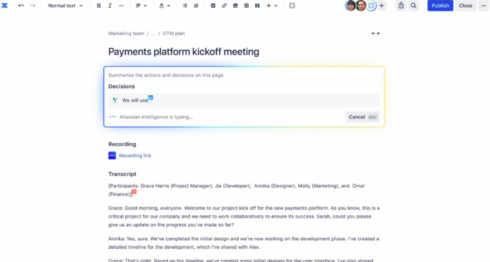
Atlassian today released a new AI tool, Atlassian Intelligence, designed to understand how teams work and to help accelerate software delivery.
The company has mined 20 years of data on how software, operations and business teams plan, track and deliver work to give Atlassian Intelligence a “unique understanding of teamwork,” according to a company blog announcing the new tool. It is that understanding upon which a teamwork graph is built around both service-based work and project-based work.
Atlassian Intelligence constructs this teamwork graph that shows the types of work being done and the relationship between them – enriched with additional context and data from the third-party apps teams use, according to the blog.
“Our mission is to unleash the potential in every team. I think with the emergence of artificial intelligence and generative AI technologies, this is a huge part of helping us accelerate teamwork. We think teamwork is going to continue to change drastically,” Sherif Mansour, head of product for Atlassian Intelligence, told SD Times in an interview.
Atlassian Intelligence is a part of the Atlassian platform, and on the service side of things, integrates with Jira Service Management to help users resolve issues more quickly, by using large language models to gain context about and intent of each request. An acquisition last year of percept.ai, along with a partnership with OpenAI, has helped Atlassian power up its virtual agents with greater understanding by combining the company’s internal models with OpenAI models.
Mansour gave the example of a worker needing access to a particular system. “In this case, [the agent] says, ‘I think you need account access.’ But it also knows related information. So, in this example, people who request access to Figma also request access to Adobe Creative Suite. It knows this because the customer has modeled in their system that they have two request types – one for Figma and one for the Creative Suite. In that example, the user will say, ‘Just Figma, please.’ “
A capability built into Jira Service Management called intents enables the virtual agent to take the request further. “In this case, the intent is for account access. And once [the user] defines an intent, they can define specific steps for that intent. We need to know what role they’re going to need access to, an edit role or view role, and with the power of cross-product automation, and scripting, the customer has automatically allowed the AI to grant access to the system, because that’s the set of rules they have defined in this example.”
On the project side, Atlassian Intelligence can help resolve issues across all Jira Cloud products, such as requesting to see which mobile features are blocking an upcoming launch, by translating a natural language query to Jira Query Language. The results of that query, pulled from Atlassian and third-party tools, can be visualized and analyzed by the newly GA Atlassian Analytics BI reporting tool to provide insights into the progress of work.
The complete blog post can be read here.
New features in Confluence
Also at its Atlassian Team ’23 event today, the company announced updates to its Confluence knowledge base, introducing whiteboards and databases. Both are nearing beta release.
Noting that every product starts with an idea, Atlassian has created whiteboards in Confluence to enable teams to turn those ideas into actionable plans in Jira. Users can use sticky notes, a pen, or stamps and timers in a whiteboard, then convert those notes into Jira Cloud issues, the company explained in its announcement. Users can view relationships between issues, such as if one piece of work is blocking another, and assign out all Jira issues to engineers.
To join the waitlist for the beta, click here.
Confluence databases are built upon the acquisition of K15t to bring structured tables in which organizations can organize things like Jira tasks, Confluence pages, statuses and due dates into one table. “Imagine an HR team tracking multiple candidates throughout the interview process, marketing teams managing complex ad campaigns, sales leveraging the latest competitive intelligence, and IT coordinating employee equipment,” the company wrote in a blog post.
To join the waitlist for the beta, click here.






